How to run business processes for section records
In Creatio, you can run a business process for a specific section record, e.g., a customer onboarding process can be run for a specific account, contact details verification process can be run for a specific contact, etc. Such a process, must be linked to the corresponding record via a process parameter of the “Id” type.
Each record in Creatio has a unique identifier (Id), i.e. a code that uniquely identifies each record in the database. The Id of the needed record can be passed to a process parameter automatically, which in turn will enable you to work with that record as part of the process flow.
Note
More information on identifying records by Id is available in the “Working with data” article.
For example, you can create a simple call scheduling business process (“Call a client”) and run it for individual records in the [Contacts] section (Fig. 1). This involves three general steps:
1.Create a unique Id parameter
2.Map the parameter to process elements
3.Add the business process to a section
When you select a record in the section and run the process, the process parameter value will be populated with the unique identifier of the selected record.
Any element that needs to work with that record can obtain its Id from the process parameter afterwards.
Fig. 1 Simple task scheduling process
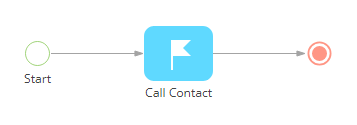
To create a process parameter that will store the unique Id of a record:
1.Open the process in the Process Designer.
2.In the process properties area, go to the [Parameters] tab.
3.Click [Add parameter] and select [Other] > [Unique identifier] (Fig. 2). This parameter will store the Id of the record for each instance of this business process.
Fig. 2 Adding an Id parameter to the process
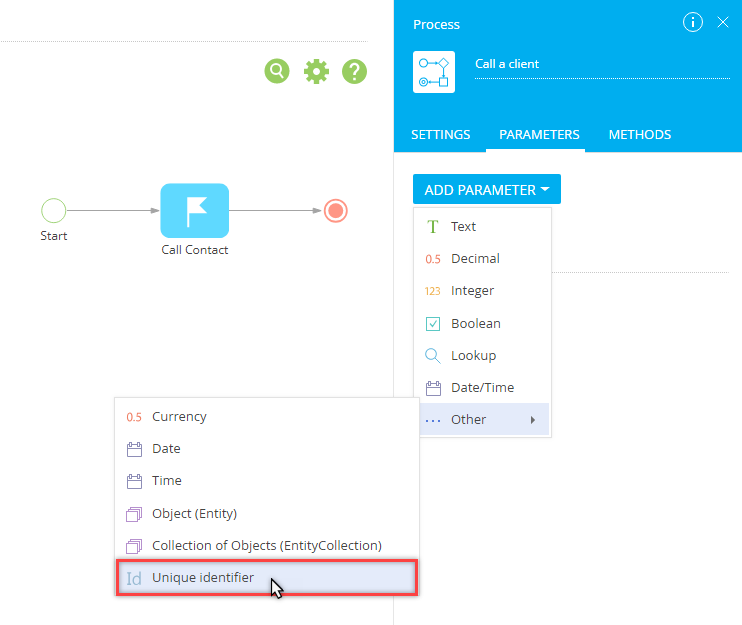
4.You can change the [Title] field to make the parameter more recognizable. The [Code] field will be populated automatically (Fig. 3).
Fig. 3 Parameter properties area
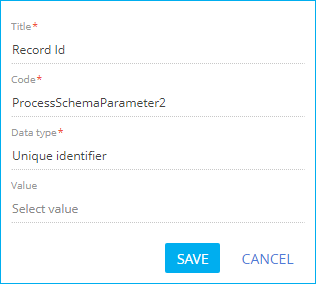
5.Click [Save] in the parameter properties area.
6.Save the process.
Map the parameter to process elements
The new process parameter can now be used to connect the necessary process elements to the section record for which the process was started. For example, you can connect the [Perform task] element to the contact record for which the process was run, and automatically populate the [Contact] field in the created task.
To map an element parameters, select the element on the diagram and make the changes in the element setup area (Fig. 4):
Fig. 4 [Perform task] process element parameters

1.Click the  button next to the field of the parameter, which must be mapped to a process parameter and select [Process parameter] from the menu (Fig. 5). For example, if the process is run for a contact record, click the [Contact] field.
button next to the field of the parameter, which must be mapped to a process parameter and select [Process parameter] from the menu (Fig. 5). For example, if the process is run for a contact record, click the [Contact] field.
Fig. 5 Selecting the process parameter
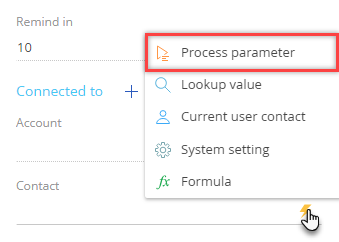
2.In the window that appears, click [Process parameters].
3.In the list of the process parameters, select the one that stores the needed value (Fig. 6). For example, you can map the [Contact] parameter of a [Perform task] element to the process parameter that stores the Id of the contact record. As a result, when the process is executed, the [Contact] field of the created task will be populated with the contact whose Id was stored in the process parameter.
Fig. 6 Parameter selection window

4.Save the process.
As a result, whenever the process is run, the value of the element parameter will be populated automatically from the corresponding process parameter. For example, the contact in the [Connected to] block in the task will be populated from the [Contact] parameter of the process.
Add the business process to a section
You can add business processes to any section using the section wizard. For example, you can add the “Call a client” process to the [Contacts] section to be run for specific contacts.
To do this:
1.Open the needed section and access the section wizard from the [View] menu.
2.Open the [Business processes] tab, and click the  button next to the [Run business process from section] field (Fig. 7).
button next to the [Run business process from section] field (Fig. 7).
Fig. 7 Adding a process to a section

3.In the window that appears, populate the following fields (Fig. 8):
Fig. 8 Business process launch settings
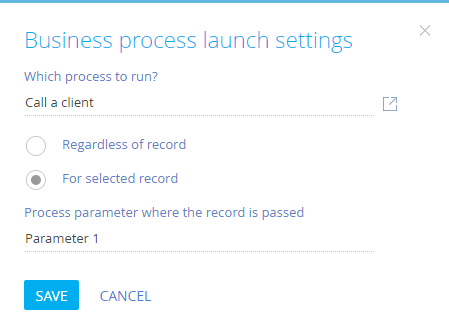
-
[Which process to run?] – select the process to run for section records. For example, you can select the “Call a client” process.
-
Select the “For selected record” option to run the process for individual records in the section.
-
In the [Process parameter where the record is passed] field, specify the process parameter, that will store the record Id. This must be a parameter of the “Id” type, such as the “Record Id parameter created earlier.
-
Save the changes.
As a result, a new “Run process” button will appear in the section list (Fig. 9) and on record pages of the section. Clicking this button will enable you to run processes for records of this section.
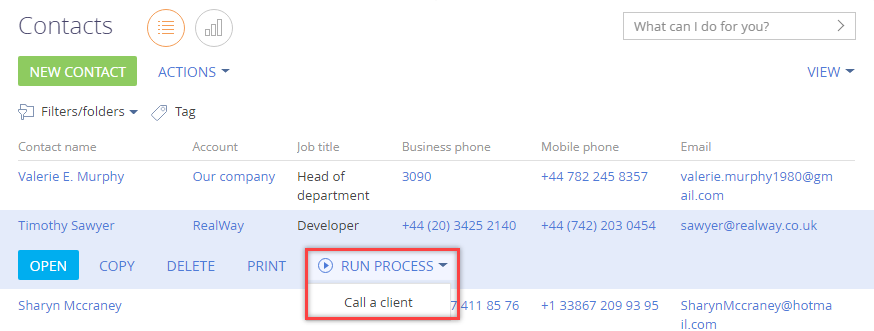
For example, running the “Call a client” process created in the previous step will automatically create a task in your calendar and connect it to the contact record for which the process was run.
See also






